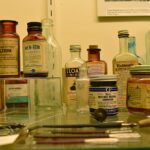 Unsplash/Andrej Lisakov
Unsplash/Andrej LisakovThroughout history, people have gone to incredible—and sometimes absurd—lengths to enhance desire or improve their chances of romance. From strange herbal concoctions to toxic minerals, love and lust have inspired some truly risky experiments. While a few remedies were little more than folklore, others were physically harmful and occasionally even deadly. Often peddled by apothecaries or whispered about in court circles, these so-called love boosters were far more dangerous than seductive.
Here’s a look at some of the most bizarre and hazardous aphrodisiacs people turned to in the name of passion.
Spanish fly
Possibly the most infamous historical aphrodisiac, Spanish fly isn’t actually a fly—it’s a bright green blister beetle. When dried and crushed, it releases a toxic compound called cantharidin. This chemical irritates the lining of the bladder and urethra, causing inflammation and a sensation that mimicked arousal.
In reality, it caused pain, discomfort, and could lead to permanent damage to internal organs. In large doses, it was deadly. Despite the danger, it was used for centuries across Europe and the Middle East. There are even unconfirmed rumours that Napoleon gave it to his soldiers. Medical texts now confirm just how risky this ‘remedy’ really was.
Lead-based makeup and powders
In the Georgian and Elizabethan eras, a pale, porcelain complexion was considered a mark of refinement and sensuality. To achieve it, women (and sometimes men) applied powders laced with white lead and vinegar—known as Venetian ceruse. The resulting ‘glow’ was admired and occasionally thought to have romantic appeal.
What it actually did was destroy the skin, cause anaemia, and result in slow, chronic poisoning. Lead entered the bloodstream through repeated use, leading to hair loss, weight loss, and eventually seizures or death. Some believed the appearance it gave—ethereal and frail—was a subtle aphrodisiac in itself.
Mandrake root
With its oddly human-shaped root, the mandrake plant fascinated people in the ancient and medieval worlds. It was tied to fertility rituals, love spells, and magical folklore, particularly in the Mediterranean and Middle East. People believed it could stir passion or ensure conception.
But mandrake contains toxic tropane alkaloids that affect the nervous system. Even small doses could cause vomiting, dizziness, and hallucinations. Higher amounts were linked to comas and death. Still, it was ground into powders, steeped in wine, or worn as a charm by those hoping to enhance their desirability.
Arsenic
It’s hard to imagine deliberately consuming arsenic, but in the 19th century, some European women did just that. Arsenic wafers and tinctures were marketed to make the skin appear smooth and luminous—traits associated with sensuality. Salesmen even claimed it could give women a romantic ‘flush.’
But arsenic is one of the most toxic substances on earth. It damages organs and accumulates in the body. Prolonged use led to nausea, confusion, hair loss, and eventual death. Yet this didn’t stop people from slipping it into beauty regimes or romantic preparations. Some believed that taking just enough—but not too much—was the key to charm.
Damiana
Native to Central and South America, damiana was used by the Mayans to enhance sexual desire. The leaves were dried and brewed into tea or mixed into tonics. Victorian herbalists in Britain adopted it in the 19th century, promoting it as a natural aphrodisiac for both men and women.
Though less dangerous than some others on this list, damiana can still cause trouble. In high doses, it may trigger hallucinations, vomiting, and irritability. Combined with alcohol or certain medications, it becomes even riskier. There was little evidence it worked, but it remained a staple in herbal shops well into the early 20th century.
Ambergris
Ambergris is a waxy substance produced in the intestines of sperm whales. Despite its pungent beginnings, it was highly valued in Renaissance and early modern Europe for its scent and supposed aphrodisiac qualities. Royals and aristocrats mixed it into chocolate, perfumes, and even medicines.
Though not outright toxic, ambergris carried health risks—especially when consumed. Its origins were often misunderstood, and it was sometimes contaminated or adulterated with harmful ingredients. It was also absurdly expensive, which meant people willing to ingest it were often doing so with little understanding of its effects. Today, its use is mostly limited to perfumery, and even then, it’s controversial.
Cantharis plasters
Derived from the same beetle used in Spanish fly, cantharis plasters were applied directly to the skin to raise blisters. The belief was that stimulating the skin and nerves would generate arousal. The pain was meant to trigger pleasure—or at least anticipation.
In practice, it did nothing of the sort. The plasters caused burns, infections, and long-term skin damage. Still, they were widely sold in 18th-century Britain and marketed as treatments for low libido. The logic was flawed, but the sales were steady, especially among the wealthy.
Belladonna
Belladonna, or deadly nightshade, was popular among Italian noblewomen in the 16th century, who used drops to dilate their pupils and create a seductive wide-eyed appearance. Some also believed ingesting small amounts could increase romantic passion.
But belladonna is extremely toxic. Its active compounds interfere with the nervous system, causing everything from blurry vision and dry mouth to convulsions and hallucinations. In larger doses, it can stop the heart. Using it for beauty or passion was one of the most dangerous cosmetic practices in European history.
Yohimbe
The bark of the yohimbe tree was traditionally used in parts of West Africa as a sexual stimulant. It became popular in 19th-century Europe, where it was sold in powdered or tincture form as a treatment for male impotence.
Modern research has shown that yohimbine—the active compound—can cause severe side effects, including high blood pressure, anxiety, and rapid heart rate. It’s now regulated or banned in several countries. But at the time, it was sold freely in chemists’ shops, despite very little oversight.
Crocodile dung pessaries
In ancient Egypt, women sometimes used dried crocodile dung as part of contraceptive or aphrodisiac practices. Mixed with other substances and inserted as a pessary, it was believed to either enhance pleasure or prevent pregnancy.
The exact reasoning isn’t well understood, but what is clear is that the risk of infection was enormous. Animal waste introduced into the body—especially in an era with no antibiotics—could easily lead to illness or death. Yet this practice persisted for centuries, likely passed down through oral tradition and ritual.
Saffron in dangerously high doses
Saffron has long been associated with fertility and sensuality in cultures from ancient Persia to medieval Europe. But while small amounts were harmless (and even beneficial), some aphrodisiac recipes called for saffron in dangerously high concentrations.
Too much saffron can cause vomiting, dizziness, numbness, and in extreme cases, internal bleeding or miscarriage. It was especially risky for pregnant women. But in pursuit of passion, it was used in drinks, perfumes, and even amulets thought to enhance allure.
Looking back, many of these remedies say more about human desperation than anything else. In a time before scientific understanding of chemistry and anatomy, people took enormous risks in the name of love, lust, and beauty. Whether it was beetles, poison, or blisters, the price of desire was often paid in pain—or worse. It’s a reminder that romance, historically, has never been without its hazards.



